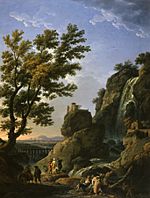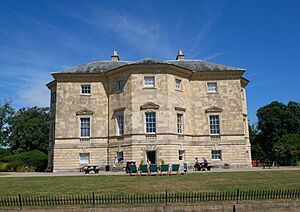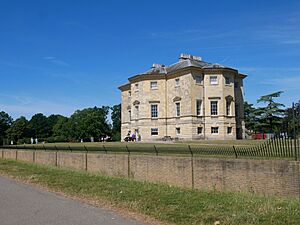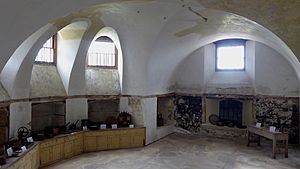Danson House facts for kids
Quick facts for kids Danson House |
|
|---|---|

The north face of Danson House, Bexley
|
|
| Type | Mansion |
| Location | Welling |
| OS grid reference | TQ 47273 75179 |
| Area | London Borough of Bexley |
| Built | 1768 |
| Architect | Robert Taylor |
| Architectural style(s) | Palladian |
| Owner | English Heritage |
|
Listed Building – Grade I
|
|
| Official name: Danson Park Mansion | |
| Designated | 1 October 1953 |
| Reference no. | 1064225 |
| Official name: Danson Park | |
| Designated | 1 October 1987 |
| Reference no. | 1000211 |
| Lua error in Module:Location_map at line 420: attempt to index field 'wikibase' (a nil value). | |
Danson House is a beautiful old mansion located in Danson Park in Welling, south-east London. It's built in a special style called Palladian, which means it looks like ancient Roman buildings. It's also a Grade I listed building, which means it's very important and protected because of its history and design.
Contents
Discovering Danson House's Past
How Danson Land Began
The land where Danson House stands has a very long history. The first records of the "Danson estates" go all the way back to 1284. At that time, seven tenants owned about 17 acres of land called "Densynton."
Later, Henry VIII, a famous English king, owned the area. It stayed part of the royal lands until King James I sold it. He needed money for the crown. In 1622, William Camden bought the land. He immediately gave it to Oxford University. This was to help pay for a history professor.
Early Owners and Changes
In 1695, the Danson estates were sold to private owners for the first time. This meant someone would live there. In 1699, John Styleman moved in. He was a director of the British East India Company. He started to make the estates into a grand country home. But he left Danson after his wife, Arabella, passed away there in 1717.
In 1723, Styleman leased the property for 99 years. The new resident was John Selwyn, a Member of Parliament. He was also a royal courtier. Selwyn made many improvements and made the estates much larger. He passed away in 1751. By then, the estate had a mansion with five bedrooms. It also had four living rooms, a nursery, kitchen, and a brewhouse. There was even an icehouse and a Chinese-style house.
Building the Grand Danson House

John Styleman had passed away in 1734. His will said that half the money from the lease should go to his widow, Mary Styleman. The other half was for charities that helped poor families in Bexley.
In 1753, Selwyn's widow, also named Mary, leased the property to Sir John Boyd. He was a sugar merchant and a leader in the British East India Company. By 1759, Boyd had taken over the lease. He also bought the rest of the land Selwyn had added. However, he still had to pay money each year to the charity. This charity owned half of the land.
Boyd wanted to own all of the land. He offered to pay the charity a fixed amount each year forever. This required a special law from Parliament. So, the Styleman Act was passed in 1762. This made John Boyd the only owner of the entire estate. This allowed him to greatly expand the property. He then built Danson House as we see it today.
The new house was first called Danson Hill. It was a Palladian villa. A famous architect named Sir Robert Taylor designed it. He also designed parts of the Bank of England. Building started in 1763. Boyd and his new wife, Catherine, moved in around 1768.
When Boyd passed away in 1800, the house was in the middle of over 600 acres of land. This included beautiful gardens and farmland. Today, over 200 acres of this land make up Danson Park. It is the second largest public park in the London Borough of Bexley.
The inside of the house was also very grand. William Chambers, a friend of Boyd's, designed the decorations. This included fancy fireplaces. Artists like Richard Wilson and Richard Corbould created paintings for the house.
The beautiful landscape around the house was designed between 1761 and 1763. It was likely done by Capability Brown or his assistant. At the center is a large, pretty 12-acre lake. It was built where the older mansion used to be. In 1797, a writer described it as "a most magnificent sheet of water." He said it looked like a beautiful winding river flowing through the grounds. A small house with a spire, called Chapel House, was built south of Danson House. It is now separated by a motorway but can still be seen today.
Danson House in Recent Times
After Sir John Boyd passed away in 1800, his son took down the large wings of the house. These wings held the kitchens and stables. He then built the stable block we see today. In 1807, he sold the estate to John Johnston. Johnston was a retired army captain.
In 1829, the estate went to Johnston's son, Hugh. Hugh's daughter, Sarah, painted many detailed watercolors of the house's interior in the 1860s. These paintings were very helpful later when the house was restored.
Hugh Johnston sold Danson to Alfred Bean in 1862. Bean was a railway engineer. He was also in charge of the Bexley Local Board. Bean imagined turning the large 582-acre estate into a residential area. Some parts of the land were sold for houses after Bean passed away in 1890. But the house and 224 acres stayed with his family.
After his widow passed away in 1921, the property was sold. The Bexley Urban District Council bought it for £16,000 in 1924. The park opened to the public in 1925. Princess Mary officially opened it.
During World War Two, the house was used for civil defense. Over time, new things were added to the park. These included football pitches, tennis courts, and a bowling green. An outdoor swimming pool was added in 1936. The Boathouse and Cafe opened to the public in 1964. Today, the park is used a lot by the community.
In 1995, English Heritage took over the house. It was in very bad condition. It had been empty since 1923. English Heritage called it "the most significant building at risk in London." It took ten years and £4.5 million to carefully restore it. Purcell Miller Tritton architects did the work.
Bexley Heritage Trust, a local charity, helped with the project from 2000. They finished furnishing and fitting out the inside of the house. Queen Elizabeth II reopened it in spring 2005. The Danson Park grounds were also restored in 2006. This was paid for by the Heritage Lottery Fund.
In 2016, the local council stopped giving money to the Bexley Heritage Trust for the house. So, the charity focused on Hall Place instead. The council then took over managing Danson House directly. The council has since made Danson House the register office for Bexley Borough. This means people can get married there.
English Heritage now owns the house with a very long lease. It is open to the public on certain days. The old stable block on the estate is now a public house, called the Danson Stables. Danson House was also used as a filming location for the 2017 TV show Taboo, which starred Tom Hardy.





